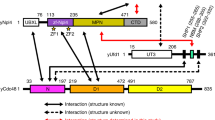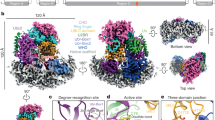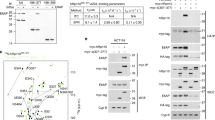Abstract
Uch37 is one of the three principal deubiquitinating enzymes (DUBs), and the only ubiquitin carboxy-terminal hydrolase (UCH)-family protease, that is associated with mammalian proteasomes. We show that Uch37 is responsible for the ubiquitin isopeptidase activity in the PA700 (19S) proteasome regulatory complex1. PA700 isopeptidase disassembles Lys 48-linked polyubiquitin specifically from the distal end of the chain, a property that may be used to clear poorly ubiquitinated or unproductively bound substrates from the proteasome. To better understand Uch37 function and the mechanism responsible for its specificity, we investigated how Uch37 is recruited to proteasomes. Uch37 binds through Adrm1, a previously unrecognized orthologue of Saccharomyces cerevisiae Rpn13p, which in turn is bound to the S1 (also known as Rpn2) subunit of the 19S complex. Adrm1 (human Rpn13, hRpn13) binds the carboxy-terminal tail of Uch37, a region that is distinct from the UCH catalytic domain, which we show inhibits Uch37 activity. Following binding, Adrm1 relieves Uch37 autoinhibition, accelerating the hydrolysis of ubiquitin-7-amido-4-methylcoumarin (ubiquitin−AMC). However, neither Uch37 alone nor the Uch37–Adrm1 or Uch37–Adrm1–S1 complexes can hydrolyse di-ubiquitin efficiently; rather, incorporation into the 19S complex is required to enable processing of polyubiquitin chains.
This is a preview of subscription content, access via your institution
Access options
Subscribe to this journal
Receive 12 print issues and online access
$209.00 per year
only $17.42 per issue
Buy this article
- Purchase on Springer Link
- Instant access to full article PDF
Prices may be subject to local taxes which are calculated during checkout





Similar content being viewed by others
References
Lam, Y. A., Xu, W., DeMartino, G. N. & Cohen, R. E. Editing of ubiquitin conjugates by an isopeptidase in the 26S proteasome. Nature 385, 737–740 (1997).
Lam, Y. A., DeMartino, G. N., Pickart, C. M. & Cohen, R. E. Specificity of the ubiquitin isopeptidase in the PA700 regulatory complex of 26 S proteasomes. J. Biol. Chem. 272, 28438–28446 (1997).
Li, T., Naqvi, N. I., Yang, H. & Teo, T. S. Identification of a 26S proteasome-associated UCH in fission yeast. Biochem. Biophys. Res. Commun. 272, 270–275 (2000).
Holzl, H. et al. The regulatory complex of Drosophila melanogaster 26S proteasomes. Subunit composition and localization of a deubiquitylating enzyme. J. Cell Biol. 150, 119–130 (2000).
Hoffman, L., Pratt, G. & Rechsteiner, M. Multiple forms of the 20 S multicatalytic and the 26 S ubiquitin/ATP-dependent proteases from rabbit reticulocyte lysate. J. Biol. Chem. 267, 22362–22368 (1992).
Wolters, D. A., Washburn, M. P. & Yates, J. R., 3rd. An automated multidimensional protein identification technology for shotgun proteomics. Anal. Chem. 73, 5683–5690 (2001).
Borodovsky, A. et al. A novel active site-directed probe specific for deubiquitylating enzymes reveals proteasome association of USP14. EMBO J. 20, 5187–5196 (2001).
Johnston, S. C., Riddle, S. M., Cohen, R. E. & Hill, C. P. Structural basis for the specificity of ubiquitin C-terminal hydrolases. EMBO J. 18, 3877–3887 (1999).
Verma, R. et al. Proteasomal proteomics: identification of nucleotide-sensitive proteasome-interacting proteins by mass spectrometric analysis of affinity-purified proteasomes. Mol. Biol. Cell 11, 3425–3439 (2000).
Leggett, D. S. et al. Multiple associated proteins regulate proteasome structure and function. Mol. Cell 10, 495–507 (2002).
Yao, T. & Cohen, R. E. A cryptic protease couples deubiquitination and degradation by the proteasome. Nature 419, 403–407 (2002).
Li, T. et al. Identification of two proteins, S14 and UIP1, that interact with UCH37. FEBS Lett. 488, 201–205 (2001).
Shimada, S., Ogawa, M., Takahashi, M., Schlom, J. & Greiner, J. W. Molecular cloning and characterization of the complementary DNA of an M(r) 110,000 antigen expressed by human gastric carcinoma cells and upregulated by gamma-interferon. Cancer Res. 54, 3831–3836 (1994).
Ito, T. et al. A comprehensive two-hybrid analysis to explore the yeast protein interactome. Proc. Natl Acad. Sci. USA 98, 4569–4574 (2001).
Giot, L. et al. A protein interaction map of Drosophila melanogaster. Science 302, 1727–1736 (2003).
Larsen, C. N., Krantz, B. A. & Wilkinson, K. D. Substrate specificity of deubiquitinating enzymes: ubiquitin C-terminal hydrolases. Biochemistry 37, 3358–3368 (1998).
Johnston, S. C., Larsen, C. N., Cook, W. J., Wilkinson, K. D. & Hill, C. P. Crystal structure of a deubiquitinating enzyme (human UCH-L3) at 1.8 A resolution. EMBO J. 16, 3787–3796 (1997).
Lamerant, N. & Kieda, C. Adhesion properties of adhesion-regulating molecule 1 protein on endothelial cells. FEBS J. 272, 1833–1844 (2005).
Sumegi, M., Hunyadi-Gulyas, E., Medzihradszky, K. F. & Udvardy, A. 26S proteasome subunits are O-linked N-acetylglucosamine-modified in Drosophila melanogaster. Biochem. Biophys. Res. Commun. 312, 1284–1289 (2003).
Simins, A. B., Weighardt, H., Weidner, K. M., Weidle, U. H. & Holzmann, B. Functional cloning of ARM-1, an adhesion-regulating molecule upregulated in metastatic tumor cells. Clin. Exp. Metastasis 17, 641–648 (1999).
Pilarsky, C., Wenzig, M., Specht, T., Saeger, H. D. & Grutzmann, R. Identification and validation of commonly overexpressed genes in solid tumors by comparison of microarray data. Neoplasia 6, 744–750 (2004).
Shimada, S., Ogawa, M., Schlom, J. & Greiner, J. W. Identification of a novel tumor-associated Mr 110,000 gene product in human gastric carcinoma cells that is immunologically related to carcinoembryonic antigen. Cancer Res. 51, 5694–5703 (1991).
Jensen, D. E. et al. BAP1: a novel ubiquitin hydrolase which binds to the BRCA1 RING finger and enhances BRCA1-mediated cell growth suppression. Oncogene 16, 1097–1112 (1998).
Lee, K. K., Florens, L., Swanson, S. K., Washburn, M. P. & Workman, J. L. The deubiquitylation activity of ubiquitinp8 is dependent upon Sgf11 and its association with the SAGA complex. Mol. Cell. Biol. 25, 1173–1182 (2005).
Das, C. et al. Structural basis for conformational plasticity of the Parkinson's disease-associated ubiquitin hydrolase UCH-L1. Proc. Natl Acad. Sci. USA 103, 4675–4680 (2006).
Misaghi, S. et al. Structure of the ubiquitin hydrolase UCH-L3 complexed with a suicide substrate. J. Biol. Chem. 280, 1512–1520 (2005).
Pace, C. N., Vajdos, F., Fee, L., Grimsley, G. & Gray, T. How to measure and predict the molar absorption coefficient of a protein. Protein Sci. 4, 2411–2423 (1995).
Dignam, J. D., Lebovitz, R. M. & Roeder, R. G. Accurate transcription initiation by RNA polymerase II in a soluble extract from isolated mammalian nuclei. Nucleic Acids Res. 11, 1475–1489 (1983).
James, P., Halladay, J. & Craig, E. A. Genomic libraries and a host strain designed for highly efficient two-hybrid selection in yeast. Genetics 144, 1425–1436 (1996).
Altschul, S. F. et al. Gapped BLAST and PSI-BLAST: a new generation of protein database search programs. Nucleic Acids Res. 25, 3389–3402 (1997).
Acknowledgements
We thank C. Gorbea and M. Rechsteiner for plasmids containing 19S complex cDNAs, A. Borodovsky and H. Ploegh for UbVS, B. Plapp for advice on fitting kinetic data and C. Slaughter for mass spectrometry of Uch37 peptides. This work was supported, in part, by the National Institutes of Health grants R01 GM37666 (to R.E.C.) and R37 GM41628 (to R.C.C.). T.Y. is a fellow of the Leukemia and Lymphoma Society.
Author information
Authors and Affiliations
Corresponding authors
Ethics declarations
Competing interests
The authors declare no competing financial interests.
Supplementary information
Supplementary Information
Supplementary Figures S1, S2, S3 and Supplementary Table S1 (PDF 1563 kb)
Rights and permissions
About this article
Cite this article
Yao, T., Song, L., Xu, W. et al. Proteasome recruitment and activation of the Uch37 deubiquitinating enzyme by Adrm1. Nat Cell Biol 8, 994–1002 (2006). https://doi.org/10.1038/ncb1460
Received:
Accepted:
Published:
Issue Date:
DOI: https://doi.org/10.1038/ncb1460
This article is cited by
-
Adhesion-regulating molecule 1 (ADRM1) can be a potential biomarker and target for bladder cancer
Scientific Reports (2023)
-
UCHL5 controls β-catenin destruction complex function through Axin1 regulation
Scientific Reports (2022)
-
Kinectin1 depletion promotes EGFR degradation via the ubiquitin-proteosome system in cutaneous squamous cell carcinoma
Cell Death & Disease (2021)
-
Deubiquitylases in developmental ubiquitin signaling and congenital diseases
Cell Death & Differentiation (2021)
-
Antibody toolkit reveals N-terminally ubiquitinated substrates of UBE2W
Nature Communications (2021)



